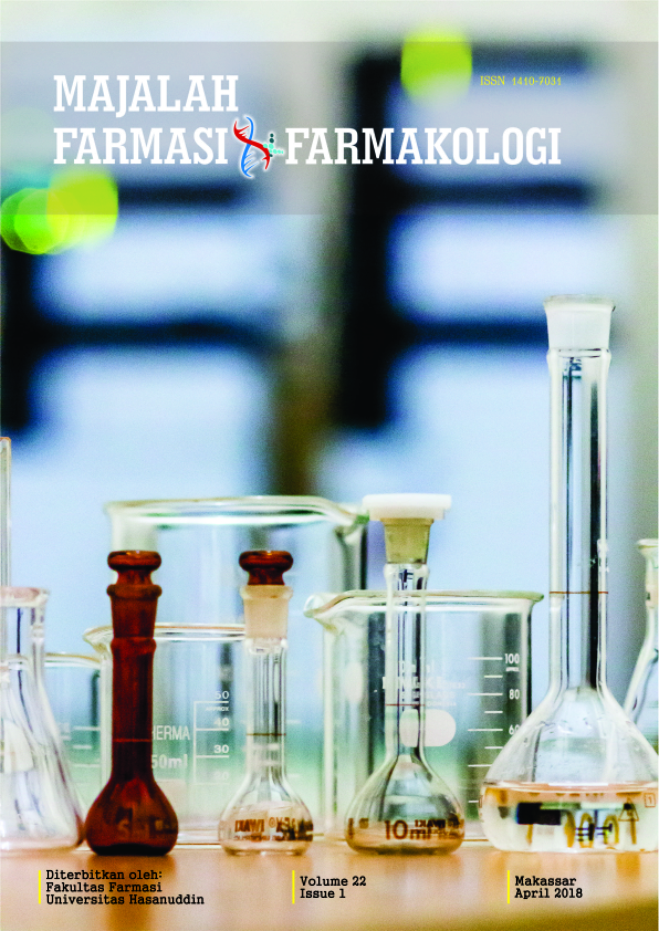DETEKSI Salmonella enterica serovar Typhimurium DALAM PRODUK PANGAN SIAP SAJI MENGGUNAKAN METODE PCR, MELT CURVE, DAN ANALISIS HRM
Abstract
Metode kultur konvensional membutuhkan waktu pengerjaan yang lama, dan sumber daya laboratorium yang besar. Olehnya itu, telah dikembangkan metode berbasis DNA dalam pengujian mikrobiologi. Tujuan penelitian ini adalah untuk menentukan metode yang tepat, dari berbagai metode berbasis DNA, dalam mendeteksi Salmonella enterica serovar Typhimurium pada produk pangan siap saji. Metode yang digunakan dalam penelitian ini adalah PCR, Melt Curve, dan Analisis HRM (High Resolution Melting). Dua gen yang digunakan sebagai target analisis molekuler dalam penelitian ini adalah invA dan fliC. Pengujian dilakukan terhadap tiga jenis sampel pangan siap saji, yaitu olahan daging, olahan unggas, dan salad buah. Hasil penelitian menunjukkan bahwa metode PCR dan Melt Curve dapat mendeteksi Salmonella enterica serovar Typhimurium menggunakan primer yang mengamplifikasi sekuens spesifik pada gen fliC. Walaupun demikian, sensitivitas yang lebih baik ditunjukkan oleh metode real-time PCR dengan nilai LOD 0,5 pg. Lebih lanjut, metode analisis HRM terbukti mampu mendeteksi Salmonella enterica serovar Typhimurium dan membedakannya dari serovar Salmonella yang lain, meskipun menggunakan primer invA yang kurang spesifik.
References
Scallan, E. et al. Foodborne Illness Acquired in the United States—Major Pathogens. Emerging Infectious Diseases. 2011. Vol. 17. 7.
Badan POM RI, 2016. Laporan Tahunan Badan POM tahun 2015, Badan POM
WHO,2018. Salmonella. http://www.who.int/foodsafety/areas_work/ foodborne-diseases. Diunduh tanggal 12-01-2018
Dodd, C., Aldsworth,T., Stein, R. et al. 2017. Foodborne Disease. Third Edition. Academic Press. London. 3, 14-17.
Campos,G.L., Suarez J.V., Urda, M.A., Alonso, V.L. 2012 Microarray Detection and Characterization of Bacterial Foodborne Pathogens. Briefs in Food, Health, and Nutrition. 13
Cheng, C.M., Doran,T., Lin,W. 2015. Interlaboratory Validation for a Real-Time PCR Salmonella Detection Method Using the ABI 7500 FAST Real-Time PCR System. Journal of Food Protection. Vol. 78. 1119-1124
Bratchikov, M., Mauricas, M. 2011. Development of a multiple-run high-resolution melting assay for Salmonella spp. Genotyping HRM application for Salmonella spp. subtyping. Diagnostic Microbiology and Infectious Disease 71. 192–200.
Shanmugasundaram,M., Radhika,M., Murali,H.S., Batra,H.V. 2009. Detection of Salmonella enterica serovar Typhimurium by selective amplification of fliC, fljB, iroB, invA,rfbJ,STM2755, STM4497 genes by polymerase chain reaction in a monoplex and multiplex format. World J. Microbiol Biotechnol. 1385-1394
Lim, Y.H.,Hirose, K.,Izumiya, H., Arakawa, E., Takahashi,H., Terajima J., Itoh,K.I., Tamura, K., Kim, S.I., Watanabe, H. 2003. Multiplex polymerase chain reaction for selective detection of Salmonella enterica Serovar Typhimurium. Japan Journal Infect. Dis. Vol. 56. 151-155.
Badan POM RI, 2014. Protokol deteksi E.coli patogen, S.typhimurium, dan V.cholerae dengan menggunakan multiplex PCR untuk kajian mikrobiologi es dan minuman es. PROM Badan POM RI. 1-9
Badan POM RI, 2003. Buku Validasi Mikrobiologi. Pusat Pengujian Obat dan Makanan Nasional., Badan POM RI, 9
FDA, 2015. Guidelines for the Validation of Analytical Methods for the Detection of Microbial Pathogens in Foods and Feeds. 2nd Edition. US Food & Drug Administration Office of Foods and Veterinary Medicine.
Barbau-Piednoir E. Botteldoorn., Yde M., Mahillon J., Roosens N.H. 2013. Development and validation of qualitative SYBR®Green real-time PCR for detection and discrimination of Listeria spp. and Listeria monocytogenes. Appl Microbiol Biotechnol 97(9):4021–4037
Lee.K.M., Runyon,M., Herrman,T.J., Phillips,R., Hsieh, J. 2015. Review of Salmonella detection and identification methods: Aspects of rapid emergency response and food safety. Food Control. Vol. 47. 264-276.
Downloads
Published
Issue
Section
License
The copyright to this article is transferred to Universitas Hasanuddin (UNHAS) if and when the article is accepted for publication. The undersigned hereby transfers all rights in and to the paper including without limitation all copyrights to UNHAS. The undersigned hereby represents and warrants that the paper is original and that he/she is the author of the paper, except for material that is clearly identified as to its original source, with permission notices from the copyright owners where required. The undersigned represents that he/she has the power and authority to make and execute this assignment.
We declare that:
- This paper has not been published in the same form elsewhere.
- It will not be submitted anywhere else for publication prior to acceptance/rejection by this Journal.
- A copyright permission is obtained for materials published elsewhere and which require this permission for reproduction.
Furthermore, I/We hereby transfer the unlimited rights of publication of the above-mentioned paper in whole to UNHAS The copyright transfer covers the exclusive right to reproduce and distribute the article, including reprints, translations, photographic reproductions, microform, electronic form (offline, online) or any other reproductions of similar nature.
The corresponding author signs for and accepts responsibility for releasing this material on behalf of any and all co-authors. This agreement is to be signed by at least one of the authors who have obtained the assent of the co-author(s) where applicable. After submission of this agreement signed by the corresponding author, changes of authorship or in the order of the authors listed will not be accepted.


